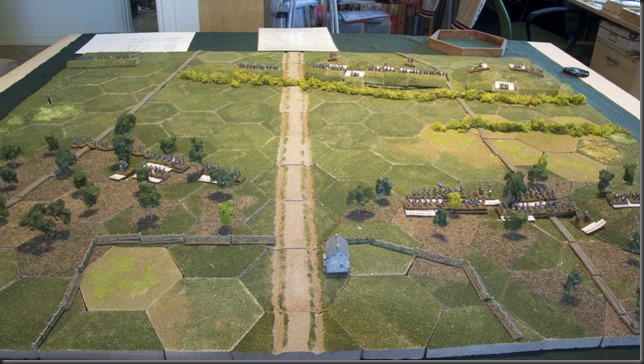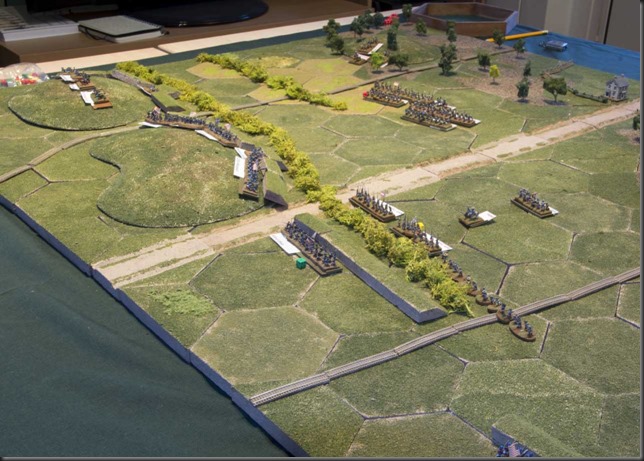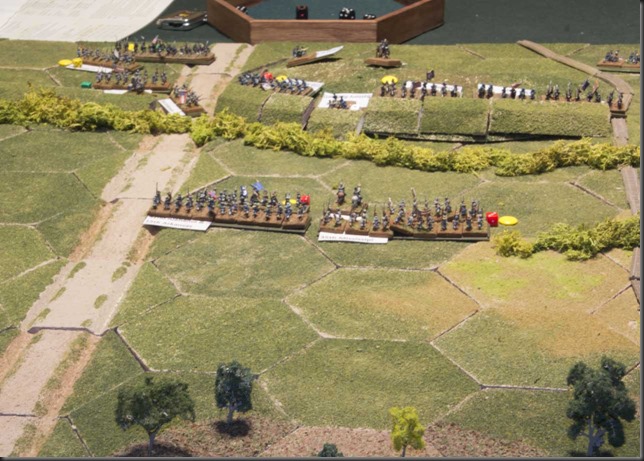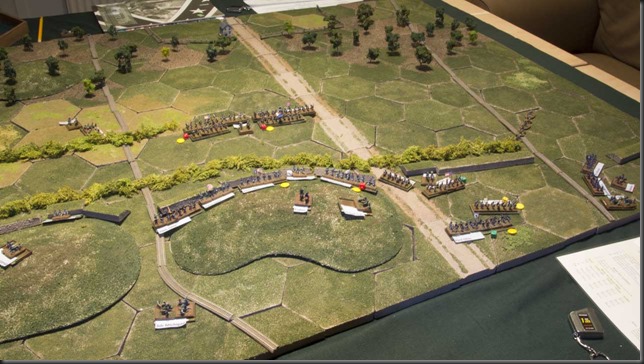Yesterday L. struggled his way to my place through the first snow storm of the winter. As a reward, he was given opportunity to repeat his achievement of taking Battery Robinett, this time around with ‘Black Powder’ rules. As it turned out, this game was quite different from the previous one and the outcome gave both of us something to think about.
The scenario and setup
For details about the scenarion, have a look at my after action report of our first attempt at ‘Battery Robinett’ scenario, played with ‘They Couldn’t Hit an Elephant’. In brief, it’s an assault/defence scenario, with Union side hunkering down in rather well fortified position, while Confederates try to charge the short distance from a wood’s edge toward a big siege gun that they attempt to capture.
Worried about the fact that Black Powder allows for quite rapid movement, I modified the terrain setup slightly and added another 15 centimeters between Confederate jumpoff point and Union line. Otherwise there were no changes whatsoever – two confederate, rather experienced, brigades were to charge pretty green Federal force of similar strength, but enjoying powerful artillery support and an entrenched position.
The game
The game was yet another short and sweet affair, with the whole thing being decided in three turns and requiring less than two hours to complete! And that time includes at least half an hour of rules discussions and clarifications!
Yet again, let’s have a look at pictures and supporting narrative.
As the purpose of the game was to compare and contrast Black Powder with TCHAE, L. declared that he would use same plan as in previous game – concentrated assault at the center of Union line with both brigades formed in two regiment wide formations. One slight deviation consisted of his placing the skirmishers on his extreme left flank; in first game, T. used them to screen the front of his brigade.
Following L.s suit, I distributed my forces in similar fashion as in previous engagement.
In first round the exact thing that I feared did take place – L. rolled extremly well on initiative for his left brigade, allowing him to move two of its regiments and skirmishers all the way toward abattis in front of Federal entrenchments. This in itself was also the biggest ‘rule failure’ of the game, as he shouldn’t have been allowed to that, since all units moving on brigade order need to end within 6’’ (or cm in our game) from each other and the rearmost brigade couldn’t advance as far as the units in front of it.
At that time however we were blissfully unaware of our blunder and I immediately had reason to fear that the game would end in rapid collapse of Union line similar to that which I experienced in TCHAE game.
L.s right brigade managed to pull off a ‘two orders’ roll for the other brigade commander, allowing it to briskly cover one third of the distance to Union entrenchments.
Confederate fire that followed was pretty ineffective, which was hardly surprising considering strength of the Union position.
Then it was my turn. In pure desperation, I sent my CinC to the right, hoping to quickly activate my two regiments that guarded that flank. The fact that both of them were low on ammo (“minus one dice to shoot with” house rule) wasn’t very encouraging, but desperate times and all that…
The effects of my fire during first phase were much more telling than L.’s, with both artillery and infantry scoring several hits on L.s lead regiments. Two of them were also disrupted, which stopped them from moving in next round and buying me some additional time before inevitable close combat.
Second round started with a ‘lucky’ two order activation roll for L.s brigade on the left. This allowed him to charge my lone regiment on that flank and just barely managing in throwing it back. Yet again, a flashback of previous game appeared in front of my eyes. This time around though, the regiment that was forced to retreat was still very much in the game.
On the right, L.s luck run out and his roll for brigade order failed. This effectively meant that his advance on that side stalled in the middle of nowhere, with dire consequences.
My second round was a mixed affair. My CinC failed with his first activation roll, leaving the regiments on my right flank in limbo. However, the results of my shooting phase were fearsome – the regiment that managed to charge beyond Union entrenchments suffered enough hits to force it to take a morale check. It stood its ground, but was now shaken. The front regiments of L.s right brigade took a fearful pounding, mainly from the entrenched siege guns, with yet another regiment becoming shaken.
In final round of the game, L. found himself under a lot of pressure. His right side brigade was in a lot of trouble. One regiment was shaken, the other was one hit from reaching that state. This was very significant for reasons described below and forced L.’s hand. He really only had one option here - try for brigade order and hope for two orders. This would allow him to bring forward the two rear regiments and mask their stricken comrades from even more fire. He managed to roll an activation with single order, which wasn’t enough to pull of that manouver and left his damaged regiments exposed to further punishment.
On the left, things went even worse for him – he failed on his first activation roll, leaving his regiments in a very exposed position…
…a fact of which I took full advantage of. My CinC finally managed to finally get his ‘s**t’ together and led the entire force on my right flank into firing position. Two artillery batteries I pulled from my left flank toward the center of my line also reached their newpositions, but were yet not able to deploy. The rest of my units just waited for orders to fire.
Once the order came, the Union fire was as effective as in round two. Multiple hits were scored on front regiments of L.’s right brigade. One of those units didn’t make its subsequent morale check and was destroyed. The other pulled through, but was shaken.
L’s other brigade suffered similar fate, only difference being that both of the regiments that suffered casualties managed to survive their subsequent morale checks. Both of them were however ‘shaken’ as we started fourth round of the game.
The game ends
‘Black Powder’ has this neat rule about brigade morale which says that once half or more of brigade’s units are either destroyed, retreated from the table or are in ‘shaken’ state at the start of controling player’s turn, that brigade has to break off the engagement. Furthermore, if half or more brigades reach that state, the entire army has to retire, in effect giving up the fight. Because of this rule, L. had to accept complete defeat at the start of round four - both of his brigades were at that time broken and needed to pull back.
Musings after the battle
Our little game clearly illustrated couple of things. First of all, ‘Black Powder’ and ‘They Couldn’t Hit an Elephant’ are two very different animals! Perhaps the most important difference between those two rulesets consists of fragility of individual units in ‘Black Powder’. Two hits in ‘TCHAE’ are, at least initially, nothing to think twice about. In ‘BP’ such event is a reason for very serious concern and could require immediate damage control. I’d go as af as saying that the thought process in a player used to ‘TCHEA’ robustness of even inexperienced units requires a major adjustment if he’s to have any success in a ‘BP’ game!
This game also confirmed another of the conclusions I presented here after the first ‘BP’ game L. and I played about a year ago – ‘BP’ is a very fast ruleset when compared to ‘TCHAE’. Not only are the units much more fragile, but movement distances are (potentially) much longer. This makes for very eventful games and quick decisions achieved in reasonable playing time. This is of course a good thing, but it also has a flip side – small games, with two or three brigades will with all probability end rather quickly, unless players really take time to nurse damaged units back to reasonable health state.
Finally, I can’t help but notice that nothing in our little engagement made me really feel we played an ACW battle. Don’t take me wrong, it was a fun and entertaining game, but it did feel like a generic game. Say what you want about TCHAE, but when you play a game with that ruleset, there are certain aspects in it that make you understand the difficulties and intricacies of the real conflict a tiny bit better. So far I have been unable to find that aspect in ‘BP’ and I can’t help but miss it a little allready.
Of course, there is a flipside also to this ‘coin’ – ‘period chrome’ has a natural appeal for a historical wargamer, but it comes at a cost of time. Many of my TCHAE after action reports include the phrase ‘…and then so and so left for home’, more often than not long before the game was decided. I suspect that ‘Black Powder’ games won’t suffer this problem and that has its own appeal.
To each his own, horses for courses, your mileage may vary…. One thing is for sure, this certainly wasn’t my last Black Powder game!





No comments:
Post a Comment